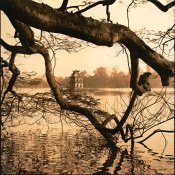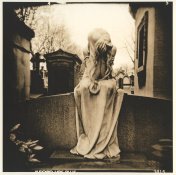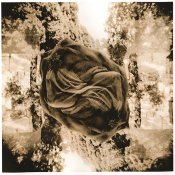M Carter: lately I've been doing what you mentioned earlier in this thread about buying expired paper, it's a real c*(p shoot. I've been focusing mostly on papers that have some chloride combination in the emulsion on the assumption that may make them a little more lith-able. I even picked up some Azo and Velox, haven't tried the Azo yet but the Velox has possibilities. My last session in the darkroom I tried some Afga Brovira that initially wasn't coming up in the developer. I gave it a quick flash with my flashlight and it came out red with some tone reversal like you would expect with solarization, it was really cool. I also tried Portriga Rapid that gave a really nice gold-brown tone. All of my exposures were 1 or two minutes wide open on the lens.
I did experience some significant and rapid bleach-back, 10 -15 seconds in the fix, with the Agfa and Kodak Polyfiber. I was using Arista liquid lith at 1:12. All in all that dilution seemed to provide some reasonable developing time, I experienced some excruciatingly long non-results with dilutions at 1:24, 1:20, & 1:15. I had forgotten about the hot developer Tim Rudman mentions, will try that in the future.
I had dingy highlights on everything and after giving it some though I may have used too much old brown, about 25%. I think I will back off on that in the future as well. I did do the develop and fix only test on unexposed samples and most were not fogged at all.
I like your example in #64 above, and Moose... I really like your first very brown/red example in #55 above. I've pretty much resolved to work at lith printing only for the foreseeable future, not having much inspiration with traditional printing of late.
Brovira can give you gorgeous lith prints, not much color but amazing deep-space blacks. Here's some tips to deal with the speed and lith in general:
Get a glass buffet-warmer or food-warmer rectangular electric thing. I think they're basically illegal now - they'll burn the PISS out of you on high - put a wet towel on it, then the tray of dev. and stick a glass thermometer in there. Shoot for 35 - 40°c. Much hotter and it can mottle the prints. You may need to rig up some ventilation, too.
Get two of them if you can - have a tray of fairly strong developer to get things started - when the image appears, move to a weaker dev and not as hot. Just let it barely get rolling. (Moersch says to try starting in strong lith, and then stop and wash once shadows appear and move to very weak sepia. Just one of a zillion crazy ideas to try.)
A third tray of just warm water and maybe a splash of old brown gives you even more control - do your final minutes in there and watch closely.
Get a flashlight that won't fog the paper - a penlight with red gel glued on the front with black silicone, something to inspect as you dev. Test it for fog. Get some of those red LED safelight bulbs and your darkroom can be bright as heck with no fogging, too.
Have your acid stop right next to everything - some papers accelerate like crazy and "just right" can be "too dark" in a matter of seconds. Flip the print over, face down into the stop.
Do dry-down tests for your paper - some papers (Ektalure) dry a full stop darker.
Fix - if you're losing too much color, try an alkaline fix. WASH the stop thoroughly from the print first.
TEST your fix for the bare minimum fix time - under safe light, cut a test strip of the paper you're using, say 1" x 4". Mark it with a sharpie, 4 lines so you have 5 segments. Soak it in water for a minute or so. Set a timer and fix the very end for 15 seconds, then dip to the next line for 15 more - do this 4 times and you'll have fixed it for 15, 30, 45, 60, and none (where you held onto it). Turn on the room lights and develop in
normal print developer. With fresh fix, the paper may be clear at 15 or 30. 15 may be a shade of yellow, and 30 white, so go with 30 as your time. (The unfixed area where you held it should be full black - if not, your dev is weak). Do this every few prints to be safe. Fix as little as possible, and consider fixing a bit weaker, like 7:1 vs. 4:1 - sometimes longer but weaker seems to bleach less - test test test!





 )
)